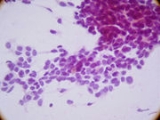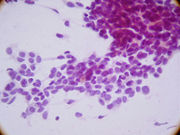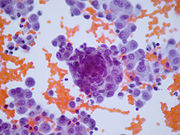
Desmoplastic small round cell tumor
Encyclopedia


Soft tissue sarcoma
A soft-tissue sarcoma is a form of sarcoma that develops in connective tissue, though the term is sometimes applied to elements of the soft tissue that are not currently considered connective tissue.-Risk factors:...
. It is an aggressive and rare tumor that primarily occurs as masses in the abdomen
Abdomen
In vertebrates such as mammals the abdomen constitutes the part of the body between the thorax and pelvis. The region enclosed by the abdomen is termed the abdominal cavity...
. Other areas affected may include the lymph nodes, the lining of the abdomen
Abdomen
In vertebrates such as mammals the abdomen constitutes the part of the body between the thorax and pelvis. The region enclosed by the abdomen is termed the abdominal cavity...
, diaphragm, spleen, liver, chest wall, skull, spinal cord, large intestine, small intestine, bladder, brain, lungs, testicles, ovaries, and the pelvis
Pelvis
In human anatomy, the pelvis is the lower part of the trunk, between the abdomen and the lower limbs .The pelvis includes several structures:...
. Reported sites of metatastic spread include the liver
Liver
The liver is a vital organ present in vertebrates and some other animals. It has a wide range of functions, including detoxification, protein synthesis, and production of biochemicals necessary for digestion...
, lung
Lung
The lung is the essential respiration organ in many air-breathing animals, including most tetrapods, a few fish and a few snails. In mammals and the more complex life forms, the two lungs are located near the backbone on either side of the heart...
s, lymph nodes, brain
Brain
The brain is the center of the nervous system in all vertebrate and most invertebrate animals—only a few primitive invertebrates such as sponges, jellyfish, sea squirts and starfishes do not have one. It is located in the head, usually close to primary sensory apparatus such as vision, hearing,...
, skull, and bone
Bone
Bones are rigid organs that constitute part of the endoskeleton of vertebrates. They support, and protect the various organs of the body, produce red and white blood cells and store minerals. Bone tissue is a type of dense connective tissue...
s.
The tumor
Tumor
A tumor or tumour is commonly used as a synonym for a neoplasm that appears enlarged in size. Tumor is not synonymous with cancer...
is considered a childhood cancer that predominantly strikes boys and young adults.
The disease rarely occurs in females, but when it does the tumors can be mistaken for ovarian cancer
Ovarian cancer
Ovarian cancer is a cancerous growth arising from the ovary. Symptoms are frequently very subtle early on and may include: bloating, pelvic pain, difficulty eating and frequent urination, and are easily confused with other illnesses....
.
Causes
There are no known risk factors that have been identified specific to the disease. The tumor appears to arise from the primitive cells of childhood, and is considered a childhood cancer.Research has indicated that there is a chimeric relationship between desmoplastic small-round-cell tumor (DSRCT) and Wilms' tumor
Wilms' tumor
Wilms' tumor or nephroblastoma is cancer of the kidneys that typically occurs in children, rarely in adults.Its common name is an eponym, referring to Dr. Max Wilms, the German surgeon who first described this kind of tumor....
and Ewing's sarcoma. Together with neuroblastoma and non-Hodgkin's lymphoma, they form the small or B cell tumors.
DSRCT is associated with a unique chromosomal translocation (t11;22)(p13:q12) resulting in a EWS
Ewing sarcoma breakpoint region 1
RNA-binding protein EWS is a protein that in humans is encoded by the EWSR1 gene.-Interactions:Ewing sarcoma breakpoint region 1 has been shown to interact with POU4F1, SF1, BARD1, Small nuclear ribonucleoprotein polypeptide C, PTK2B and Zinc finger protein 165.ERG, ATF-1,-External links:* on the...
/WT1
WT1
Wilms tumor protein is a protein that in humans is encoded by the WT1 gene.- Function :This gene encodes a transcription factor that contains four zinc finger motifs at the C-terminus and a proline / glutamine-rich DNA-binding domain at the N-terminus...
transcript that is diagnostic of this tumor. This transcript codes for a protein that acts as a transcriptional activator that fails to suppress tumor growth.
The EWS/WT1 translocation product targets ENT4. ENT4 is also known as PMAT.
Symptoms
There are few early warning signs that a patient has a DSRCT. Patients are often young and healthy as the tumors grow and spread uninhibited within the abdominal cavity. These are rare tumors and symptoms are often misdiagnosed by family physicians. The abdominal masses can grow to enormous size before being noticed by the patient. The tumors can be felt as hard, round masses by palpating the abdomen.First symptoms of the disease often include abdominal distention, abdominal mass, abdominal or back pain, gastrointestinal obstruction, lack of appetite, ascites
Ascites
Ascites is a gastroenterological term for an accumulation of fluid in the peritoneal cavity.The medical condition is also known as peritoneal cavity fluid, peritoneal fluid excess, hydroperitoneum or more archaically as abdominal dropsy. Although most commonly due to cirrhosis and severe liver...
, anemia, and/or cachexia
Cachexia
Cachexia or wasting syndrome is loss of weight, muscle atrophy, fatigue, weakness, and significant loss of appetite in someone who is not actively trying to lose weight...
.
Other reported symptoms include unknown lumps, thyroid conditions, hormonal conditions, blood clotting, kidney or urological problems, testicle, breast, uterine, vaginal, or ovarian masses
Differential Diagnoses
Because this is a rare tumor, not many family physicians or oncologists are familiar with this disease. DSRCT in young patients can be mistaken for other abdominal tumors including rhabdomyosarcomaRhabdomyosarcoma
A rhabdomyosarcoma is a type of cancer, specifically a sarcoma , in which the cancer cells are thought to arise from skeletal muscle progenitors. It can also be found attached to muscle tissue, wrapped around intestines, or in any anatomic location...
, neuroblastoma
Neuroblastoma
Neuroblastoma is the most common extracranial solid cancer in childhood and the most common cancer in infancy, with an annual incidence of about 650 cases per year in the US , and 100 cases per year in the UK . Close to 50 percent of neuroblastoma cases occur in children younger than two years old...
, and mesenteric carcinoid
Carcinoid
Carcinoid is a slow-growing type of neuroendocrine tumor, originating in the cells of the neuroendocrine system.In 2000, the World Health Organization redefined "carcinoid", but this new definition has not been accepted by all practitioners. This has led to some complexity in distinguishing...
. In older patients DSRCT can resemble lymphoma
Lymphoma
Lymphoma is a cancer in the lymphatic cells of the immune system. Typically, lymphomas present as a solid tumor of lymphoid cells. Treatment might involve chemotherapy and in some cases radiotherapy and/or bone marrow transplantation, and can be curable depending on the histology, type, and stage...
, peritoneal mesothelioma
Peritoneal mesothelioma
Peritoneal mesothelioma is the name given to the cancer that attacks the lining of the abdomen. This type of cancer affects the lining that protects the contents of the abdomen and which also provides a lubricating fluid to enable the organs to move and work properly.The peritoneum is made of two...
, and peritoneal carcinomatosis. In males DSRCT may be mistaken for germ cell or testicular cancer
Testicular cancer
Testicular cancer is cancer that develops in the testicles, a part of the male reproductive system.In the United States, between 7,500 and 8,000 diagnoses of testicular cancer are made each year. In the UK, approximately 2,000 men are diagnosed each year. Over his lifetime, a man's risk of...
while in females DSRCT can be mistaken for Ovarian cancer. DSRCT shares characteristics with other small-round blue cell cancers including Ewing's sarcoma, acute leukemia, small cell mesothelioma, neuroblastoma, primitive neuroectodermal tumor
Primitive neuroectodermal tumor
Primitive neuroectodermal tumor is a neural crest tumor. It is a rare tumor, usually occurring in children and young adults under 25 years of age...
, rhabdomyosarcoma
Rhabdomyosarcoma
A rhabdomyosarcoma is a type of cancer, specifically a sarcoma , in which the cancer cells are thought to arise from skeletal muscle progenitors. It can also be found attached to muscle tissue, wrapped around intestines, or in any anatomic location...
, and Wilms' tumor.
Pathology
The entity was first described by pathologists William L. Gerald and Juan RosaiJuan Rosai
Juan Rosai, M.D. is an Italian-born American physician who has contributed to clinical research in the subspecialty of surgical pathology. He is the principal author and editor of a major textbook in that field, and he has characterized novel medical conditions such as Rosai-Dorfman disease and...
in 1989. Pathology reveals well circumscribed solid tumor nodules within a dense desmoplastic stroma. Often areas of central necrosis are present. Tumor cells have hyperchromatic nuclei with increased nuclear/cytoplasmic ratio.
On immunohistochemistry, these cells have trilinear coexpression including the epithelial marker cytokeratin, the mesenchymal markers desmin and vimentin, and the neuronal marker neuron-specific enolase. Thus, although initially thought to be of mesothelial origin due to sites of presentation, it is now hypothesized to arise from a progenitor cell with multiphenotypic differentiation.
Treatment
DSRCT is frequently misdiagnosed. Adult patients should always be referred to a sarcoma specialist. This is an aggressive, rare, fast spreading tumor and both pediatric and adult patients should be treated at a sarcoma center.There is no standard protocol for the disease; however, recent journals and studies have reported that some patients respond to high dose (P6 Protocol) chemotherapy
Chemotherapy
Chemotherapy is the treatment of cancer with an antineoplastic drug or with a combination of such drugs into a standardized treatment regimen....
, maintenance chemotherapy, debulking operation, cytoreductive surgery, and radiation therapy
Radiation therapy
Radiation therapy , radiation oncology, or radiotherapy , sometimes abbreviated to XRT or DXT, is the medical use of ionizing radiation, generally as part of cancer treatment to control malignant cells.Radiation therapy is commonly applied to the cancerous tumor because of its ability to control...
. Other treatment options include: hematopoietic stem cell transplantation, intensity-modulated radiation Therapy, radiofrequency ablation
Radiofrequency ablation
Radio frequency ablation is a medical procedure where part of the electrical conduction system of the heart, tumor or other dysfunctional tissue is ablated using the heat generated from the high frequency alternating current to treat a medical disorder...
, stereotactic body radiation therapy, intraperitoneal hyperthermic chemoperfusion
Intraperitoneal hyperthermic chemoperfusion
Intraperitoneal hyperthermic chemoperfusion is a type of hyperthermia therapy used in combination with surgery in the treatment of advanced abdominal cancers. In this procedure, warmed anti-cancer drugs are infused and circulated in the peritoneal cavity for a short period of time...
, and clinical trial
Clinical trial
Clinical trials are a set of procedures in medical research and drug development that are conducted to allow safety and efficacy data to be collected for health interventions...
s.
Prognosis
The prognosis for DSRCT remains poor. The 5-year survival rate of DRSCT is only approximately15%. Prognosis depends upon the stage of the cancer. Because the disease can be misdiagnosed or remain undetected, tumors frequently grow large within the abdomen and metastasized
Metastasis
Metastasis, or metastatic disease , is the spread of a disease from one organ or part to another non-adjacent organ or part. It was previously thought that only malignant tumor cells and infections have the capacity to metastasize; however, this is being reconsidered due to new research...
or seed to other parts of the body.
There is no known organ or area of origin. DSRCT can metastasize through lymph nodes or the blood stream. Sites of metastatis include the spleen, diaphragm, liver, large and small intestine, lungs, central nervous system, bones, uterus, bladder, genitals, abdominal cavity, and the brain.
A multi-modality approach of high dose chemotherapy, aggressive surgical resection, radiation, and stem cell rescue improves survival for some patients. Reports have indicated that patients will initially respond to first line chemotherapy and treatment but that relapse is common.
Some patients in remission or with inoperable tumor seem to benefit from long term low dose chemotherapy, turning DSRCT into a chronic disease.
Research
The Stehlin Foundation currently offers DSRCT patients the opportunity to send samples of their tumors free of charge for testing. Research scientists are growing the samples on nude mice and testing various chemical agents to find which are most effective against the individual's tumor.Patients with advanced DSRCT may qualify to participate in clinical trials that are researching new drugs to treat the disease.
Alternative names
This disease is also known as: desmoplastic small round blue cell tumor; intraabdominal desmoplastic small round blue cell tumor; desmoplastic small cell tumor; desmoplastic cancer; desmoplastic sarcoma; DSRCT.There is no connection to peritoneal mesothelioma
Peritoneal mesothelioma
Peritoneal mesothelioma is the name given to the cancer that attacks the lining of the abdomen. This type of cancer affects the lining that protects the contents of the abdomen and which also provides a lubricating fluid to enable the organs to move and work properly.The peritoneum is made of two...
which is another disease sometimes described as desmoplastic.

